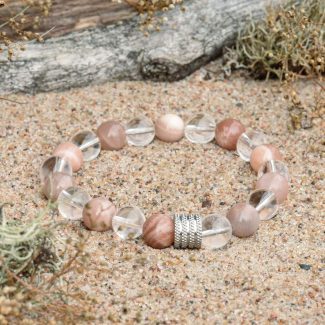Feldspar Gemstone
Feldspar is a group of rock-forming minerals that constitute the majority of the Earth’s crust. Composed of aluminum, silicon, and oxygen atoms arranged in a 3-dimensional framework, feldspar minerals are commonly found in igneous, metamorphic, and sedimentary rocks. They are vital components of everyday products such as glass, ceramics, and construction materials.
There are two main types of feldspars: potassium feldspars, which contain potassium, and plagioclase feldspars, which contain calcium and sodium. These minerals help geologists understand the processes that formed the Earth’s crust and are economically significant as raw materials for manufacturing. In this article, we will discuss the properties and uses of feldspar, its geological significance, and its role in our daily lives.
Nature of Feldspar Stone
Feldspar makes up around 60% of the Earth’s crust and is a common mineral found in igneous, metamorphic, and sedimentary rocks. It is composed of aluminum, silicon, and oxygen atoms and is the most abundant mineral group on Earth. Feldspar often occurs alongside minerals like quartz and mica.
Feldspar is divided into two groups: alkali feldspar (e.g., orthoclase, microcline) and plagioclase feldspar (e.g., albite, anorthite). Both groups are essential rock-forming minerals with different chemical compositions and crystal structures.
Feldspar comes in various colors, including pink, red, green, and gray, and can be opaque or translucent. It has a Mohs hardness of 6, making it relatively scratch-resistant. It is also resistant to weathering and erosion, often found in sedimentary rocks.
The mineral is widely used in manufacturing ceramics and glass, providing strength and durability to finished products. Feldspar is also a flux in glassmaking, lowering the melting temperature of the glass. Additionally, it is used as a building material in countertops, flooring, and walls and as a component in abrasives like sandpaper and grinding wheels.
Background Study of Feldspar Stone
Feldspar, making up about 60% of the Earth’s crust by volume, is a group of minerals composed of aluminum silicates mixed with potassium, sodium, or calcium. It is widely used in industries like ceramics, glass, and construction.
In ceramics, feldspar is used as a flux to lower the melting temperature of materials, essential in producing tiles, sanitaryware, and tableware. In glassmaking, feldspar improves transparency and reduces melting temperatures. It is also a filler and extender in cement and other construction materials.
Feldspar has geological significance as it helps determine the age of rocks and formations. Potassium feldspar, in particular, contains radioactive isotopes useful for dating geological samples.
Different Types of Feldspar Stone
- Orthoclase Feldspar: Known as potassium feldspar, it is pink, white, or gray and used in ceramics and glassmaking.
- Plagioclase Feldspar: Found in igneous rocks, composed of calcium and sodium, and is white, gray, or bluish.
- Amazonite: A green variety of microcline feldspar, often used in jewelry.
- Moonstone: Exhibits a unique light play called adularescence and is pearly white or grayish, popular in jewelry.
- Sunstone: Displays iridescence due to copper inclusions, with reddish-brown or yellow hues, used in jewelry.
Colors of Feldspar Stone
Feldspar is available in colors like white, pink, orange, gray, and green, determined by impurities within the mineral:
- Pink Feldspar: Commonly found in granite, its pink hue is due to manganese.
- Green Feldspar: Found in schist and gneiss, its green color is caused by chromium.
- Blue Feldspar: Rare, found in syenite and granite, its blue color is due to copper.
Physical Properties of Feldspar Stone
- Hardness: Mohs scale 6–6.5
- Cleavage: Two planes intersecting at 90 degrees
- Colors: White, gray, pink, and green
- Luster: Vitreous or glassy
- Streak: White
- Transparency: Transparent to translucent
Chemical Properties of Feldspar Stone
- Chemical Composition: Aluminum, silicon, oxygen, potassium, sodium, or calcium
- Melting Point: 1100–1300°C
- Insolubility: Resistant to water and most acids
- Reactivity: Reacts with hydrofluoric acid to produce silicon fluoride
- Weathering: Susceptible to chemical weathering
- Electrical Properties: Exhibits piezoelectric behavior
Benefits of Using Feldspar Stone
- Ceramics and Glass: Key ingredient for strength and durability
- Construction: Used in tiles, cement, and bricks
- Paint Industry: Acts as a filler and pigment extender
- Metallurgy: Removes impurities in smelting
- Abrasives: Enhances hardness in grinding wheels
- Agriculture: Improves soil fertility and water retention
Care of Feldspar Stone
- Avoid harsh chemicals like bleach or ammonia
- Clean with mild detergent and water
- Use coasters and trivets to prevent scratches
- Seal periodically with a stone sealer
Where to Buy Feldspar Stone
You can purchase high-quality feldspar stones from WithinCrystals, a trusted online store offering an extensive selection of feldspar varieties like orthoclase, plagioclase, and microcline. With competitive pricing and excellent customer service, WithinCrystals ensures you receive authentic, high-quality products that meet your needs.
FAQs About Feldspar Stone
- What are the types of feldspar stones? Plagioclase and alkali feldspar, including labradorite, orthoclase, and microcline.
- What are feldspar’s uses? Glassmaking, ceramics, cement, and abrasives.
- What are feldspar’s physical properties? Hardness 6, specific gravity 2.5–2.7, vitreous luster.
- Where is feldspar found? Found globally, with major deposits in China, India, and the USA.
Conclusion
Feldspar is a versatile mineral with applications in ceramics, glassmaking, and construction. Its unique properties make it invaluable in various industries, and its use as a gemstone adds to its significance. Feldspar is a vital resource with widespread practical uses.













